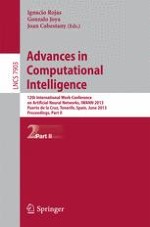2013 | Buch
Advances in Computational Intelligence
12th International Work-Conference on Artificial Neural Networks, IWANN 2013, Puerto de la Cruz, Tenerife, Spain, June 12-14, 2013, Proceedings, Part II
herausgegeben von: Ignacio Rojas, Gonzalo Joya, Joan Cabestany
Verlag: Springer Berlin Heidelberg
Buchreihe : Lecture Notes in Computer Science
